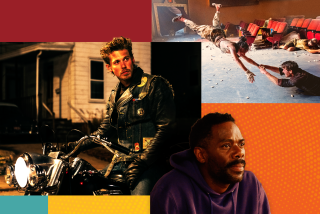Sean Penn takes sympathy ‘Into the Wild’
- Share via
An enigmatic young man named Chris McCandless made an indelible impression on any number of people during his short life, and you can now add Sean Penn to the list.
“Into the Wild,” Penn’s film on McCandless’ experiences, is a complete change of pace for the writer-director. It’s his warmest, most celebratory and most completely realized film and, though you might not guess it from the material, it is also arguably his most personal.
Penn’s film, starring a radiant Emile Hirsch, is based on Jon Krakauer’s nonfiction book about McCandless, an unusual 24-year-old “possessed of a streak of stubborn idealism that did not mesh readily with modern existence.” In April 1992, McCandless’ search for “raw, transcendent experience” led him to walk alone into Alaska’s Denali National Park, determined to have adventures and live dangerously off the land. He did not come out alive.
Krakauer’s book, the only source of information on McCandless’ life, touched a major nerve -- 2 million copies in print, nearly two years on the New York Times bestseller list -- and the reasons are not hard to see. For this was the kind of paradigmatic young person it was possible to both extravagantly admire and deeply despair of, a stern intolerant moralist as well as a giddy, buoyant enthusiast, someone perhaps best viewed as a walking Rorschach test. Was he a foolish naif or a great, transcendent spirit? The Chris you saw depended on the one you wanted to see.
Penn has followed Krakauer’s telling of McCandless’ life with considerable fidelity, but he’s also made critical changes in organization and tone, changes that should have been fatal but end up being unexpectedly affecting on screen.
For though Krakauer was enormously sympathetic to McCandless, he is too good a reporter not to view his subject with dispassion. Penn’s portrait, by contrast, is completely congratulatory. He focuses almost entirely on McCandless’ sweetness and idealism, emphasizing the largeness of his spirit in an attempt to mythologize him as an avatar of advanced consciousness.
In line with this, though Krakauer tells us up front that McCandless died, Penn postpones this knowledge till the very end of the film. Even the cover text of the bestselling paperback has been changed, and a sentence talking about McCandless’ demise has been deftly removed for the movie tie-in edition. Penn has written a voice-over for McCandless’ devoted sister Carine (Jena Malone) to deepen our emotional connection, and he also divides his material into sections with titles such as “Manhood,” “Family” and “Getting of Wisdom,” all in an attempt to convince us that McCandless lived a rich, full life despite his youthful death.
On one level, given his bleaker-than-bleak previous films such as “The Crossing Guard” and “The Pledge,” Penn would seem an unlikely candidate to have uplifted a story rather than dampened it. Yet as the nearly 10 years he persevered to get the rights testifies, Penn clearly felt a powerful connection to this material. In fact, it’s not too much to say that the filmmaker sees aspects of himself in this uncompromising idealist with a backbone of steel and feels that in another life this story might well have been his own.
Though Penn’s fierce identification with the protagonist is a key source for the film’s accomplishments, “Into the Wild” succeeds on screen because Hirsch (“Alpha Dog,” “The Lords of Dogtown”) throws himself into the part without reservation, projecting an appealing openness and life force that brings a special poignancy to his fate. His presence instinctively softens whatever hard edges McCandless would otherwise project and the naturalness of his performance transfers to the entire film.
“Into the Wild” starts with McCandless going exactly there, cheerfully heading out into the Alaskan fastness after being dropped at a trail head by a local (played by Alaskan Jim Gallien, who was that driver in real life) in a pickup truck.
McCandless almost immediately finds an abandoned school bus, dragged up there decades before to house road construction workers. He quickly and efficiently sets himself up inside and exults in having gone where he always wanted to go. It’s the high point of his young life, and “Into the Wild” continually cuts back and forth between what happened in and around the bus and McCandless’ pre-Alaska existence.
We see him graduating from Emory University in Atlanta and having dinner with his sister and his slave-to-convention parents (gamely played by Marcia Gay Harden and William Hurt), whose roles as the unpleasant ogres of the piece are the film’s most noticeable weakness.
Without telling anyone, McCandless promptly heads out for the wide world, hitchhiking around the country and, in a burst of youthful bravado, deciding to grandly rename himself “Alexander Supertramp” and coldly cutting himself off from any contact with his family.
Much of “Into the Wild’s” 2 1/2 -hour length is taken up by the people “Alex” meets. There is a live-wire grain elevator operator (a fine Vince Vaughn), an old hippie couple (Catherine Keener and newcomer Brian Dierker) and, most involving of all, a testy 80-year-old man finely played by the veteran Hal Holbrook.
One troubling conceit of “Into the Wild” is that McCandless is so evolved he helps everyone he meets over rough spots in their lives, asking nothing in return and in fact shunning messy human intimacy. After a while, especially as his time in Alaska turns him increasingly gaunt, it’s hard to shake the feeling that the film is, perhaps unintentionally, grafting Christ-like attributes onto this unlikely figure.
But counterbalancing whatever awkward moments “Into the Wild” has are its virtues, including striking outdoor photography from Eric Gautier (who performed the same service for “The Motorcycle Diaries”) and strong melodic music from Michael Brook, Kaki King and Pearl Jam’s Eddie Vedder. And, of course, there is Hirsch. No one on screen can resist his joyous presence, and “Into the Wild” is counting on the fact that you won’t be able to do so either.
--
“Into the Wild.” MPAA rating: R, for language and some nudity. Running time: 2 hours, 30 minutes. In general release.
More to Read
Only good movies
Get the Indie Focus newsletter, Mark Olsen's weekly guide to the world of cinema.
You may occasionally receive promotional content from the Los Angeles Times.











